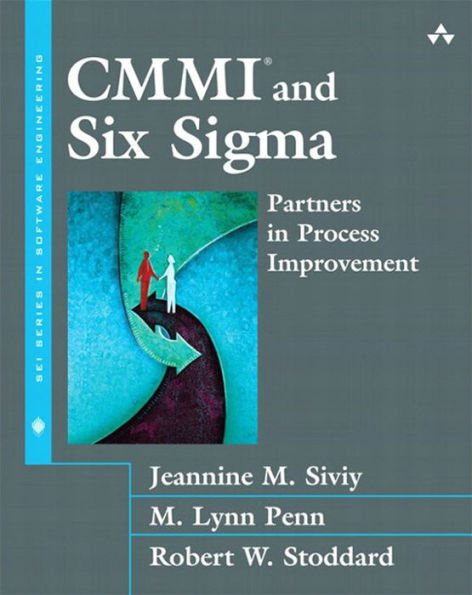"In this book, I have found answers to key questions and misconceptions about the relationship between Six Sigma and the Capability Maturity Model Integration [CMMI]....Among my key takeaways is that the relationship between Six Sigma and CMMI exemplifies one of the principles of S4/IEE: CMMI provides process infrastructure that is needed to support a successful Six Sigma strategy."
—Forrest W. Breyfogle III, CEO, Smarter Solutions, Inc.
"Finally, a book that bridges the software and hardware process tool set. To date, there have been hardware and software engineers who for one reason or another have not communicated their process methods. And so, myths formed that convinced the hardware community that CMMI was only for software and likewise convinced the software community that Six Sigma was only for hardware. It is both refreshing and thought provoking to dispel these myths."
—Jack Ferguson, Manager, SEI Appraisal Program, Software Engineering Institute
CMMI and Six Sigma represent two of the best-known process improvement initiatives. Both are designed to enhance work quality and thereby produce business advantages for an organization. It's a misconception that the two are in competition and cannot be implemented simultaneously. Practitioners originally trained in either CMMI or Six Sigma are now finding that the two initiatives work remarkably well together in the pursuit of their common goal.
CMMI® and Six Sigma: Partners in Process Improvement focuses on the synergistic, rather than competitive, implementation of CMMI and Six Sigma—with synergy translating to "faster, better, cheaper" achievement of mission success. Topics range from formation of the value proposition to specific implementation tactics. The authors illustrate how not taking advantage of what both initiatives have to offer puts an organization at risk of sinking time, energy, and money into "inventing" a solution that already exists. Along the way they debunk a few myths about Six Sigma applications in software.
While the authors concentrate on the interoperability of Six Sigma and CMMI, they also recognize that organizations rarely implement only these two initiatives. Accordingly, the discussion turns to the emerging realm of "multimodel" process improvement and strategies and tactics that transcend models to help organizations effectively knit together a single unified internal process standard.
Whether you work in the defense industry, for a commercial organization, or for a government agency—wherever quality and efficiency matter—you'll find this book to be a valuable resource for bridging process issues across domains and building an improvement strategy that succeeds.
"In this book, I have found answers to key questions and misconceptions about the relationship between Six Sigma and the Capability Maturity Model Integration [CMMI]....Among my key takeaways is that the relationship between Six Sigma and CMMI exemplifies one of the principles of S4/IEE: CMMI provides process infrastructure that is needed to support a successful Six Sigma strategy."
—Forrest W. Breyfogle III, CEO, Smarter Solutions, Inc.
"Finally, a book that bridges the software and hardware process tool set. To date, there have been hardware and software engineers who for one reason or another have not communicated their process methods. And so, myths formed that convinced the hardware community that CMMI was only for software and likewise convinced the software community that Six Sigma was only for hardware. It is both refreshing and thought provoking to dispel these myths."
—Jack Ferguson, Manager, SEI Appraisal Program, Software Engineering Institute
CMMI and Six Sigma represent two of the best-known process improvement initiatives. Both are designed to enhance work quality and thereby produce business advantages for an organization. It's a misconception that the two are in competition and cannot be implemented simultaneously. Practitioners originally trained in either CMMI or Six Sigma are now finding that the two initiatives work remarkably well together in the pursuit of their common goal.
CMMI® and Six Sigma: Partners in Process Improvement focuses on the synergistic, rather than competitive, implementation of CMMI and Six Sigma—with synergy translating to "faster, better, cheaper" achievement of mission success. Topics range from formation of the value proposition to specific implementation tactics. The authors illustrate how not taking advantage of what both initiatives have to offer puts an organization at risk of sinking time, energy, and money into "inventing" a solution that already exists. Along the way they debunk a few myths about Six Sigma applications in software.
While the authors concentrate on the interoperability of Six Sigma and CMMI, they also recognize that organizations rarely implement only these two initiatives. Accordingly, the discussion turns to the emerging realm of "multimodel" process improvement and strategies and tactics that transcend models to help organizations effectively knit together a single unified internal process standard.
Whether you work in the defense industry, for a commercial organization, or for a government agency—wherever quality and efficiency matter—you'll find this book to be a valuable resource for bridging process issues across domains and building an improvement strategy that succeeds.

CMMI and Six Sigma: Partners in Process Improvement
368
CMMI and Six Sigma: Partners in Process Improvement
368
Product Details
| ISBN-13: | 9780132702362 |
|---|---|
| Publisher: | Pearson Education |
| Publication date: | 12/18/2007 |
| Series: | SEI Series in Software Engineering |
| Sold by: | Barnes & Noble |
| Format: | eBook |
| Pages: | 368 |
| File size: | 6 MB |
| Age Range: | 18 Years |
